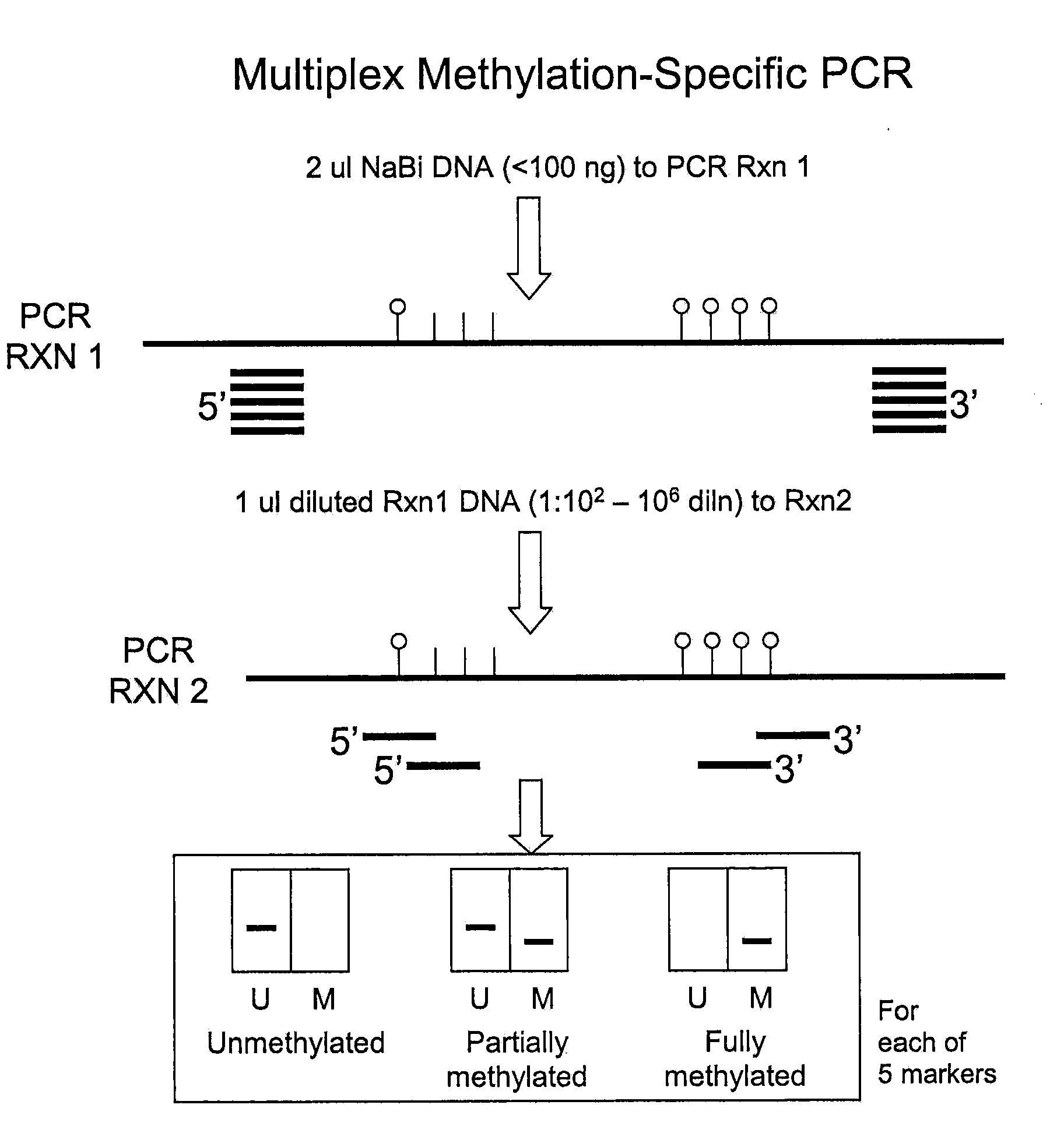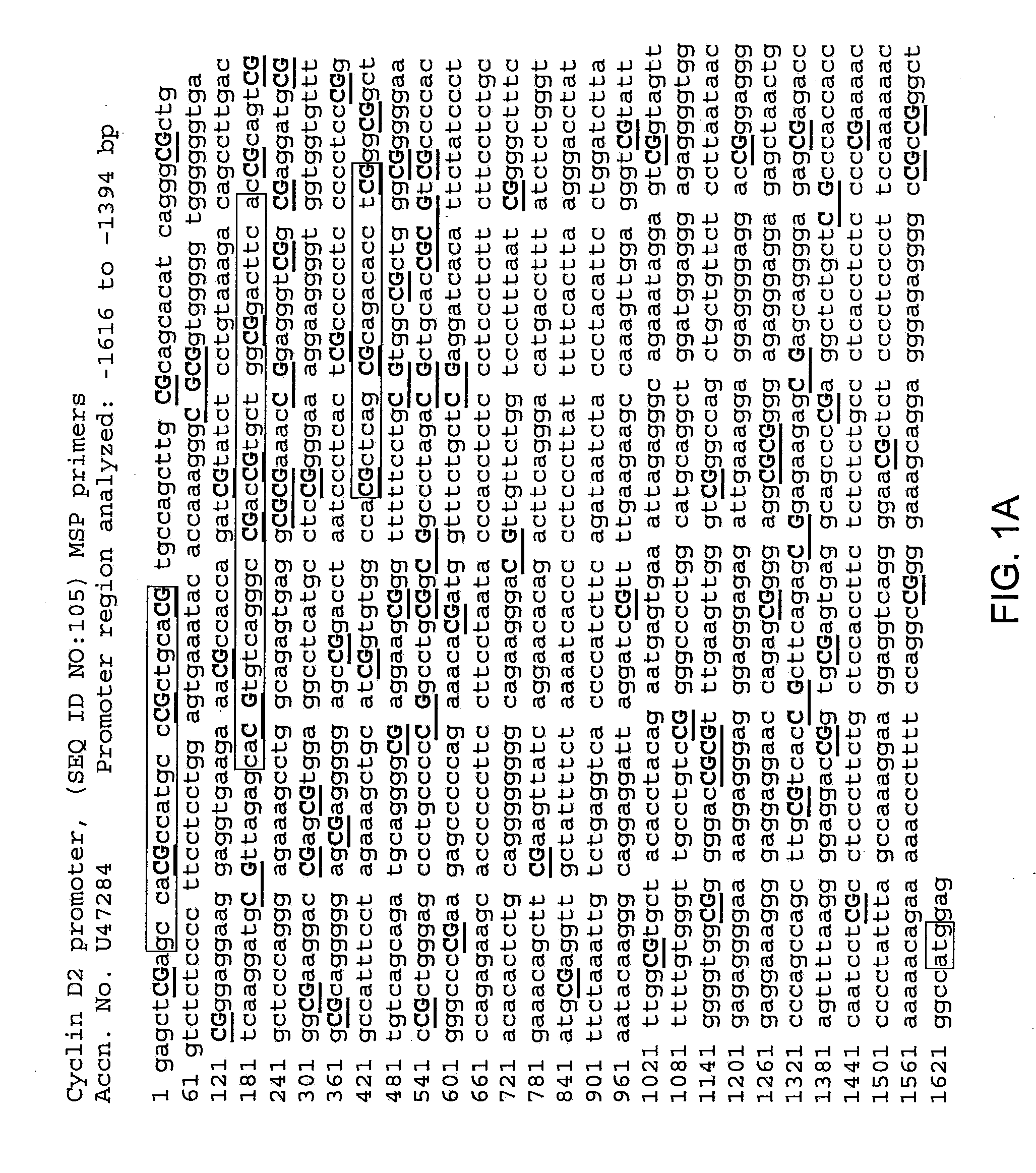Aberrantly Methylated Genes as Markers of Breast Malignancy
a gene and gene technology, applied in the field of breast malignancy marker, can solve the problems of limiting therapeutic options and survival rates, limiting the differentiation between malignant and benign breast disease, and not establishing the precise role of abnormal dna methylation in human tumorogenesis
- Summary
- Abstract
- Description
- Claims
- Application Information
AI Technical Summary
Benefits of technology
Problems solved by technology
Method used
Image
Examples
example 1
Methylation Status of Wilms' Tumor Suppressor Gene (WT1)
[0090]The extent of methylation of the WT1-associated CpG islands in normal mammary epithelium, in breast cancer cell lines, and in primary mammary tumors, and expression of the WT1 mRNA and protein in the same cells and tissues was examined.
[0091]Cell lines and finite life span cultures Cell lines were obtained from ATCC (Rockville, Md.) and grown according to conditions specified. Also utilized were three independent cultures of finite life span human mammary epithelial cells (HMEC): 16637 (Clonetics, Walkersville, Md.) and 1-26, 3-14 (kindly provided by Dr. Steve Ethier, Univ. Michigan, Ann Arbor, Mich.). When indicated, cell lines were treated with 0.75 μM 5-aza-2′-deoxycytidine (5-aza-dC) or with 100 ng / ml Trichostatin A (TSA) as described in Ferguson, et al. (Proc Natl Acad Sci USA. (2000) 97:6049-54).
[0092]Tumors and Organoids Primary breast tumors were obtained from the Johns Hopkins frozen tumor bank. Mammary organoids...
example 2
Hypermethylation and Loss of Expression of Cyclin D2
[0113]The extent of methylation of the cyclin D2-associated CpG islands in normal mammary epithelium, in breast cancer cell lines, and in primary mammary tumors, and expression of the cyclin D2 mRNA and protein in the same cells and tissues was examined.
[0114]Cell Lines and Tissues The breast cancer cell lines MDAMB435, MCF7, T47D, SKBR3, ZR75.1, MDAMB468, HS578T, MDAMB231 and the immortal human mammary epithelial cell lines (HMEC) MCF10A and HBL100 were obtained and maintained in culture according to instructions (ATCC, Rockville, Md.). The two matched tumor cell lines, 21PT, derived from a primary tumor and 21MT, from the metastasis of the same patient, were propagated as described elsewhere. The breast cancer cell line, MW, was obtained from Dr. Renato Dulbecco. HMEC-H16N (immortalized with HPV) was kindly provided by Dr. Vimla Band. Cultured finite life span human breast epithelial cell strains 04372, 219-6, and 166372 were obt...
example 3
Hypermethylation and Loss of Expression of 14-3-3 Sigma
[0132]The extent of methylation of the cyclin 14-3-3 sigma-associated CpG islands in normal mammary epithelium, in breast cancer cell lines, and in primary mammary tumors, and expression of the 14.3.3 sigma mRNA and protein in the same cells and tissues was examined.
[0133]Cell Lines and Tissues The breast cancer cell lines Hs578t, MDA-MB-231, MDA-MB-435 and MCF-7 and the human mammary epithelial cell lines, MCF-10A and HBL-100 were obtained and maintained according to instructions (ATCC). The two matched tumor cell lines, 21PT and 21MT were propagated as described (Band, et al. (1990) Cancer Res. 50:7351-7357). Cultured normal human breast epithelial cell (HMEC) strains, 161, 184, 172, and 48, and the conditionally and fully immortal cell lines, 184A1 (passage 15 and 99), and 185B5 were grown as described (http: / / www.lbl.gov / LBL-Programs / mrgs / review.html). Three additional short term cultures of HMECs, (#04372 and #16637) were g...
PUM
| Property | Measurement | Unit |
|---|---|---|
| diameter | aaaaa | aaaaa |
| temperatures | aaaaa | aaaaa |
| temperature | aaaaa | aaaaa |
Abstract
Description
Claims
Application Information
 Login to View More
Login to View More - R&D
- Intellectual Property
- Life Sciences
- Materials
- Tech Scout
- Unparalleled Data Quality
- Higher Quality Content
- 60% Fewer Hallucinations
Browse by: Latest US Patents, China's latest patents, Technical Efficacy Thesaurus, Application Domain, Technology Topic, Popular Technical Reports.
© 2025 PatSnap. All rights reserved.Legal|Privacy policy|Modern Slavery Act Transparency Statement|Sitemap|About US| Contact US: help@patsnap.com



